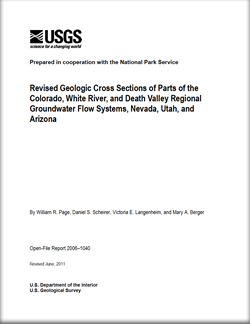 Abstract
Abstract
This report presents revisions to parts of seven of the ten cross sections originally published in U.S. Geological Survey Open-File Report 2006–1040. The revisions were necessary to correct errors in some of the original cross sections, and to show new parts of several sections that were extended and (or) appended to the original section profiles. Revisions were made to cross sections C–C’, D–D’, E–E’, F–F’, G–G’, I–I’, and J–J’, and the parts of the sections revised or extended are highlighted below the sections on plate 1 by red brackets and the word "revised," or "extended." Sections not listed above, as well as the interpretive text and figures, are generally unchanged from the original report. Cross section C–C’ includes revisions in the east Mormon Mountains in the east part of the section; D–D’ includes revisions in the Mormon Mesa area in the east part of the section; E–E’ includes revisions in the Muddy Mountains in the east part of the section; F–F’ includes revisions from the Muddy Mountains to the south Virgin Mountains in the east part of the section; and J–J’ includes some revisions from the east Mormon Mountains to the Virgin Mountains. The east end of G–G’ was extended about 16 km from the Black Mountains to the southern Virgin Mountains, and the northern end of I–I’ was extended about 45 km from the Muddy Mountains to the Mormon Mountains, and revisions were made in the Muddy Mountains part of the original section.
This report contains 10 interpretive cross sections and an integrated text describing the geology of parts of the Colorado, White River, and Death Valley regional groundwater flow systems in Nevada, Utah, and Arizona. The primary purpose of the report is to provide geologic framework data for input into a numerical groundwater model. Therefore, the stratigraphic and structural summaries are written in a hydrogeologic context.
The oldest rocks (basement) are Early Proterozoic metamorphic and intrusive crystalline rocks that are considered confining units because of their low permeability. Late Proterozoic to Lower Cambrian clastic units overlie the crystalline rocks and are also considered confining units within the regional flow systems. Above the clastic units are Middle Cambrian to Lower Permian carbonate rocks that are the primary aquifers in the flow systems. The Middle Cambrian to Lower Permian carbonate rocks are overlain by a sequence of mainly clastic rocks of late Paleozoic to Mesozoic age that are mostly considered confining units, but they may be permeable where faulted.
Tertiary volcanic and plutonic rocks are exposed in the northern and southern parts of the study area. In the Clover and Delamar Mountains, these rocks are highly deformed by north- and northwest-striking normal and strike-slip faults that are probably important conduits in transmitting groundwater from the basins in the northern Colorado and White River flow systems to basins in the southern part of the flow systems.
The youngest rocks in the region are Tertiary to Quaternary basin-fill deposits. These rocks consist of middle to late Tertiary sediments consisting of limestone, conglomerate, sandstone, tuff, and gypsum, and younger Quaternary surficial units consisting of alluvium, colluvium, playa deposits, and eolian deposits. Basin-fill deposits are both aquifers and aquitards.
The rocks in the study area were complexly deformed by episodes of Mesozoic compression and Cenozoic extensional tectonism. Some Cretaceous thrust faults and folds of the Sevier orogenic belt form duplex zones and define areas of maximum thickness for the Paleozoic carbonate rocks. Cenozoic faults are important because they are the primary structures that control groundwater flow in the regional flow systems.